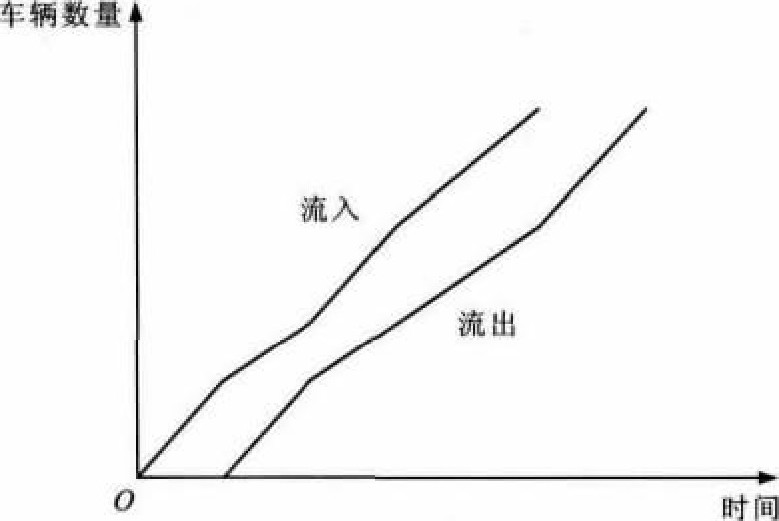Identification method of dynamic road traffic network vulnerability
-
摘要: 分析了路段和节点的流量传播过程与离散的瞬时动态用户最优路径选择均衡条件, 建立了反应型的动态用户均衡网络交通流模型, 设计了对角化的启发式算法求解模型, 评价了动态化的道路网络脆弱性指数。分析结果表明: 在自由流速度为40km·h-1、堵塞密度为125veh·km-1的9节点12路段构成的算例路网中, 在时刻3路段1受损时, 路段3在高峰时的车辆数量从原有的50veh增加到了100veh, 入口流量增加1倍, 路段2的入口流量降为0;在路段3、6、7和10构成的路径上, 路段1受损使得此路径的车辆数将近增加1倍, 车辆数量的增加导致各路段的阻抗增加。提出的方法能刻画车辆绕开受损路段的交通流传播过程, 能有效辨识道路网络在各个路段各个时刻的脆弱性。Abstract: The trfffc flow propagation process of section and node and the discrete instantaneous dynamic equilibrium condition of optimal route choice for user were analyzed, the reactive traffic flow model of dynamic user equilibrium network was established, diagonalizable heuristic algorithm was designed to solve the model, and the dynamic vulnerability index of road network was evaluated.Analysis result shows for an example road network with 12 sections and 9 nodes, free-flow speed is 40 km·h-1 and jam density is 125 veh·km-1, when section 1 is broken at time 3, vehicle amount at peak time increases from the original 50 veh to 100 veh at section 3, the inflow of section 3 increases by 1 time, and the inflow of section 2 drops to 0.The damage of section 1 doubles the vehicles on the path consisting of sections 3, 6, 7 and 10, the increase of vehicle amount leads to the increase of impedance on each section.The traffic flow propagation process of vehicle bypassing the broken section can be described, the proposed method is effective to identify the vulnerability of road network for each section at each time.
-
Key words:
- traffic planning /
- traffic network /
- vulnerability /
- disaster /
- dynamic equilibrium
-
表 1 路段长度与自由流时间
Table 1. Lengths and free-flow times of sections

表 2 OD需求
Table 2. OD demand

表 3 阻抗函数系数
Table 3. Impedance function coeffcients

-
[1] BERDICA K. An introduction to road vulnerability: what has been done, is done and should be done[J]. Transport Policy, 2002, 9 (2): 117-127. doi: 10.1016/S0967-070X(02)00011-2 [2] SAREWITZ D, PIELKE R, KEYKHAH M. Vulnerability and risk: some thoughts from a political and policy perspective[J]. Risk Analysis, 2003, 23 (4): 805-810. doi: 10.1111/1539-6924.00357 [3] D'ESTE G M, TAYLOR M A P. Network vulnerability: an approach to reliability anaysis at the level of national strategic transport networks[C]//IIDA Y, BELL M G H. The Network Reliability of Transport. Oxford: Elsevier, 2003: 23-44. [4] HOLMGREN A. Vulnerability analysis of electrical power delivery networks[R]. Stockholm: Royal Institute of Technology, 2004. [5] SOHN J. Evaluating the significance of highway hetwork links under the flood damage: an sccessibility spproach[J]. Transportation Research Part A: Policy and Practice, 2006, 40 (5): 491-506. [6] SOHN J, KIM T J, HEWINGS G J D, et al. Retrofit priority of transportation network links under an earthquake[J]. Journal of Urban Planning and Development, 2003, 129 (4): 195-210. doi: 10.1061/(ASCE)0733-9488(2003)129:4(195) [7] JENELIUS E, PETERSEN T, MATTSSON L. Importance and exposure in road network vulnerability analysis[J]. Transportation Research Part A: Policy and Practice, 2006, 40 (7): 537-560. doi: 10.1016/j.tra.2005.11.003 [8] SCOTT D M, NOVAK D C, AULTMAN-HALL L, et al. Network robustness index: a new method for identifying critical links and evaluating the performance of transportation networks[J]. Journal of Transport Geography, 2006, 14 (3): 215-227. doi: 10.1016/j.jtrangeo.2005.10.003 [9] 廖军, 安毅生, 张绍阳, 等. 路段动态交通安全综合评价模型[J]. 交通运输工程学报, 2009, 9 (4): 79-84. doi: 10.3321/j.issn:1671-1637.2009.04.016LIAO Jun, AN Yi-sheng, ZHANG Shao-yang, et al. Synthesized evaluation model of dynamic traffic safety for road section[J]. Journal of Traffic and Transportation Engineering, 2009, 9 (4): 79-84. (in Chinese). doi: 10.3321/j.issn:1671-1637.2009.04.016 [10] 张勇, 屠宁雯, 姚林泉. 城市道路交通网络脆弱性辨识方法[J]. 中国公路学报, 2013, 26 (4): 154-161. doi: 10.3969/j.issn.1001-7372.2013.04.021ZHANG Yong, TU Ning-wen, YAO Lin-quan. Urban road traffic network vulnerability identification method[J]. China Journal of Highway and Transport, 2013, 26 (4): 154-161. (in Chinese). doi: 10.3969/j.issn.1001-7372.2013.04.021 [11] SULLIVAN J L, NOUAK D C, AULTMAN-HALL L, et al. Identifying critical road segments and measuring system-wide robustness in transportation networks with isolating links: a link-based capacity-reduction approach[J]. Transportation Research Part A: Policy and Practice, 2010, 44 (5): 323-336. doi: 10.1016/j.tra.2010.02.003 [12] 刘思峰, 万寿庆, 陆志鹏, 等. 复杂交通网络中救援点与事故点间的路段重要性评价模型研究[J]. 中国管理科学, 2009, 17 (1): 119-124. doi: 10.3321/j.issn:1003-207X.2009.01.017LIU Si-feng, WAN Shou-qing, LU Zhi-peng, et al. The importance of highway section evaluation model in complex network between accident point and rescue point in the emergency situations[J]. Chinese Journal of Management Science, 2009, 17 (1): 119-124. (in Chinese). doi: 10.3321/j.issn:1003-207X.2009.01.017 [13] 杨露萍, 钱大琳. 道路交通网络脆弱性研究[J]. 交通运输系统工程与信息, 2012, 12 (1): 105-110. doi: 10.3969/j.issn.1009-6744.2012.01.016YANG Lu-ping, QIAN Da-lin. Vulnerability analysis of road networks[J]. Journal of Transportation Systems Engineering and Information Technology, 2012, 12 (1): 105-110. (in Chinese). doi: 10.3969/j.issn.1009-6744.2012.01.016 [14] BELL M G H, KANTURSKA U, SCHMÖCKER J D, et al. Attacker-defender models and road network vulnerability[J]. Philosophical Transactions of the Royal Society A: Mathematical, Physical and Engineering Sciences, 2008, 366 (2): 1893-1906. [15] BELL M G H. The use of game theory to measure the vulnerability of stochastic networks[J]. IEEE Transactions on Reliability, 2003, 52 (1): 63-68. doi: 10.1109/TR.2002.808062 [16] PAMELA M M, MAHMASSANI H. Methodology for determining vulnerable links in a transportation network[J]. Transportation Research Record, 2004 (1882): 88-96. [17] 刘天亮, 黄海军, 陈剑. 考虑风险规避和认知更新的日常择路行为演进[J]. 交通运输工程学报, 2008, 8 (4): 90-94, 103. doi: 10.3321/j.issn:1671-1637.2008.04.018LIU Tian-liang, HUANG Hai-jun, CHEN Jian. Evolution of day-to-day route choice behavior considering risk aversion and perception updating[J]. Journal of Traffic and Transportation Engineering, 2008, 8 (4): 90-94, 103. (in Chinese). doi: 10.3321/j.issn:1671-1637.2008.04.018 [18] RAN B, BOYCE D E. A link-based variational inequality formulation of ideal dynamic user-optimal route choice problem[J]. Transportation Research Part C: Emerging Technologies, 1996, 4 (1): 1-12. doi: 10.1016/0968-090X(95)00017-D [19] LARSSON T, PATRIKSSON M. An augmented Lagrangean dual algorithm for link capacity side constrained traffic assignment problems[J]. Transportation Research Part B: Methodological, 1995, 29 (6): 433-455. doi: 10.1016/0191-2615(95)00016-7 [20] RAN B, BOYCE D E, LEBLANC L J. A new class of instantaneous dynamic user-optimal traffic assignment models[J]. Operations Research, 1993, 4 (1): 192-202. [21] 张菁, 陈荔. 道路网结构可靠性分析[J]. 长安大学学报: 自然科学版, 2010, 30 (4): 77-81. https://www.cnki.com.cn/Article/CJFDTOTAL-XAGL201004017.htmZHANG Jing, CHEN Li. Reliability analysis on structure stability of regional road network[J]. Journal of Chang'an University: Natural Science Edition, 2010, 30 (4): 77-81. (in Chinese). https://www.cnki.com.cn/Article/CJFDTOTAL-XAGL201004017.htm [22] 宋永朝, 潘晓东, 陈聪, 等. 面向应急疏散的山区公路交通节点连通性研究[J]. 中国公路学报, 2010, 23 (4): 102-106, 126. https://www.cnki.com.cn/Article/CJFDTOTAL-ZGGL201004018.htmSONG Yong-chao, PAN Xiao-dong, CHEN Cong, et al. Study of connectivity of traffic nodes on mountainous highway for emergency evacuation[J]. China Journal of Highway and Transport, 2010, 23 (4): 102-106, 126. (in Chinese). https://www.cnki.com.cn/Article/CJFDTOTAL-ZGGL201004018.htm [23] 赵岩, 高社生, 姜微微. 突发灾难下大型路网中的人员疏散模型[J]. 长安大学学报: 自然科学版, 2013, 33 (2): 89-94. https://www.cnki.com.cn/Article/CJFDTOTAL-XAGL201302017.htmZHAO Yan, GAO She-sheng, JIANG Wei-wei. Model of a large-scale transportation network for evacuation under emergency[J]. Journal of Chang'an University: Natural Science Edition, 2013, 33 (2): 89-94. (in Chinese). https://www.cnki.com.cn/Article/CJFDTOTAL-XAGL201302017.htm [24] 郑长江, 李悦, 王婷. 非常态下城市道路交通检测器布局优化方法[J]. 中国公路学报, 2011, 24 (5): 100-106. https://www.cnki.com.cn/Article/CJFDTOTAL-ZGGL201105017.htmZHENG Chang-jiang, LI Yue, WANG Ting. Layout optimization method of urban road traffic detectors under abnormal state[J]. China Journal of Highway and Transport, 2011, 24 (5): 100-106. (in Chinese). https://www.cnki.com.cn/Article/CJFDTOTAL-ZGGL201105017.htm [25] LIAO Fei-xiong, ARENTZE T, TIMMERMANS H. Multi-state supernetworks: recent progress and prospects[J]. Journal of Traffic and Transportation Engineering: English Edition, 2014, 1 (1): 13-27. -





 下载:
下载:












